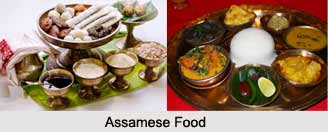 The culture of Assam is formed by co-mingling cultural elements of South East Asian countries. It is constituted of different sub systems. Symbolism is a key element of Assamese culture. Significant symbolic elements are Tamulpan, Xorai and Gamosa. Assamese are hospitable and revered their ancestors; they show reverence towards betel leaves, symbolic clothes like Gamosa and traditional silk.
The culture of Assam is formed by co-mingling cultural elements of South East Asian countries. It is constituted of different sub systems. Symbolism is a key element of Assamese culture. Significant symbolic elements are Tamulpan, Xorai and Gamosa. Assamese are hospitable and revered their ancestors; they show reverence towards betel leaves, symbolic clothes like Gamosa and traditional silk.
Festivals of Assam
Bihu is the most popular festival celebrated by Assamese .The word Bihu is a derivation of "visuvan" implying all the Indian festivals colligated with March equinox. It is the celebration to welcome seasons and it is vital for a farmer"s life in Assam. Although this festival retained its originality it incorporated specific characteristics of the city life. Three Bihus namely rongali, the bhogali and kongali are observed at different times:
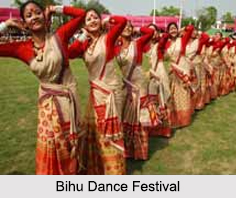 Rongali Bihu or Bohag Bihu: It is feted at the offset of the sowing season during spring. It also marks the beginning of Assamese new year and around 15th April as per English calendar. Truly, it is celebrated in the territory of Assam in great fiesta. Women make "desi" sweets called "pithas" and "larus". Bihugeets, traditional folk songs are composed to create an ambience of delight. In the Lakhimpur area of Assam "Pat Bihu, an archaic form of Bihu, is feted with ebullience. The myth is that Sukaphaa, the 1st among the Ahom kings, came to the region to have a glance of it. Rongali Bihu is regarded as a festival of fertility and the young women are encouraged to participate with great enthusiasm, dancing and singing throughout.
Rongali Bihu or Bohag Bihu: It is feted at the offset of the sowing season during spring. It also marks the beginning of Assamese new year and around 15th April as per English calendar. Truly, it is celebrated in the territory of Assam in great fiesta. Women make "desi" sweets called "pithas" and "larus". Bihugeets, traditional folk songs are composed to create an ambience of delight. In the Lakhimpur area of Assam "Pat Bihu, an archaic form of Bihu, is feted with ebullience. The myth is that Sukaphaa, the 1st among the Ahom kings, came to the region to have a glance of it. Rongali Bihu is regarded as a festival of fertility and the young women are encouraged to participate with great enthusiasm, dancing and singing throughout.
Kongali Bihu: It is observed when the fields are lavish but the barns are abandoning. It is the time of full harvest. This is an occasion of less fun and frolic. Earthen lamps, popularly known as saki, are illuminated near the paddy fields and at "tulaxi" plant"s feet. Farmers chanted and spinned the bamboo piece to avert devilish forces.
Bhogali Bihu: It is celebrated after harvesting the crops. It is also known as Magh Bihu as it is celebrated in the middle of January. Fun, feasts, community feeding are parts of it. Small huts called mejis are built for preparing food and feasting. During night the people circle around the bonfire and sing and play games. In the next morning they throw "pithas" and betel nuts in the fire. They also worship fire Gods marking the final harvesting season. There are other conventional festivals observed by various "enthno- cultural" groups. Me-dam-me-phi, Ali-aye-ligang, Porag, Garja, Hapsa Hatarnai, Kherai are few among them.
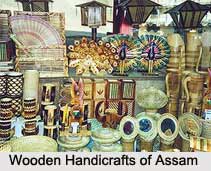 Music of Assam
Music of Assam
Music is an integral part of Assamese culture. The people of diverse communities took shelter in various provinces and thus enhanced the musical affluence. Descending scale and pyramidal structure are the characteristic feature of Assam music. Dhaol, Marcus, Taal, Pepa, Gogona are the various musical instruments used during the performance. The types of music are:
Bharigaan: The wooden theatrical mask of the Rabhas of Assam is associated with the performance of Bharigaan, a lesser known theatrical drama, enacted by the Rabha community of Assam. The performance is based on the subjects of local folklores and Hindu mythology.
Jhumur: The subject of the Jhumur songs are conventional, which are related to day-to-day chores of the commoners. Originally Jhumur was meant to be a source of entertainment for cultivators. It got its nomenclature due to its unique feature of binding cluster of bells round the ankles. Clangorous noise of the bells soothes the audience mind. It is, nowadays, performed as a ritual in the worship of Gods and also as a prayer for rainfall.
Bihugeet: It is an indispensable part of Bihu festival. During Husori, an integral part of Rongali Bihu, the villagers, in groups, move from door-to-door, joyfully singing carols. These chorus groups are known as Husori parties and only men could participate. At first the Husori singers would visit the "Naamghar". Then they reach the household gate (podulimukh) heralding their arrival with beating drums. Thanksgiving of the housekeepers with "tamul" is followed by the singers" new-year blessings to the house.
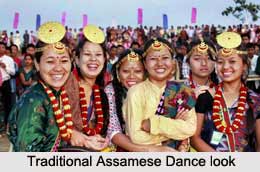 Regional Folk Music: Kamrupiya Lokageet, Goalporiya Lokageet, Ojapali are some of the popular folk Music of Assam.
Regional Folk Music: Kamrupiya Lokageet, Goalporiya Lokageet, Ojapali are some of the popular folk Music of Assam.
Language of Assam
It is home to several ethnic communities, mainly speaking official languages like Assamese and Bodo. Bengali too is spoken in Assam especially in Barak Valley. The Assamese have got literary flair; fine literary works have developed from this region of the country.
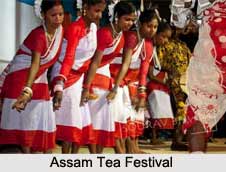 Literature of Assam
Literature of Assam
The Charyapadas is regarded as the earliest instance of literature in Assam. During 17th to 19th Century, prose chronicles, namely, Buranji, were in vogue. It flourished in the courts of Ahoms. The Modern era saw the marked influences of Missionaries. The American Baptists first published Bible in Assamese in the year 1819. In the year 1836, they also formed the first printing press in Sibsagar and local Asamiya dialect was used for the first time for writing. A monthly periodical called Arunodoi, and the first book on Assamese Grammar were also published during this period. In 1867, The Missionaries printed the first Assamese-English Dictionary and M. Bronson hoarded it. Jyoti Prasad Agarwalla, Hem Barua and others had embellished the modern Assamese literature with their masterpieces. It is also the land of renowned poets namely Anupama Basumatary, Ajit Barua, Anis-Uz-Zaman.
Assamese Art
Assam too had a treasure of exquisite crafts and artifacts. It is copious in producing brass craft, metal craft, mask- making, potteries, cane and bamboo crafts, and jewelry. Assam is known to the world for its dainty silk named Assam Silk. The silk tinged with golden embroideries is known as Muga. Others include Pat silk, which is cream colored meshed with silver color. Nice woolens called Eri are found here.
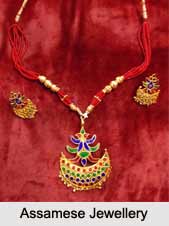 The lineage of Assam rulers had presented the region with marvelous paintings. The people of Assam are very fond of sculpture and various art forms like applied arts of Patuas and Chitrakars. During Medieval period, important works of paintings include Hastividyarnava, Chitra Bhagawata and the Gita Govinda have influenced the Assamese literature. Local painters used local paints like hangool and haital.
The lineage of Assam rulers had presented the region with marvelous paintings. The people of Assam are very fond of sculpture and various art forms like applied arts of Patuas and Chitrakars. During Medieval period, important works of paintings include Hastividyarnava, Chitra Bhagawata and the Gita Govinda have influenced the Assamese literature. Local painters used local paints like hangool and haital.
Cuisine of Assam
The cuisine of Assam is oriented to typical East Indian style. Various local styles and external influences have contributed in the food preparation. Foods are less spicy but have strong smell due to ample use of fruits and vegetables that are dried out and soured. A traditional Assamese meal starts with khar and gets completed by tenga, a sour dish. The betel leaves and paan are the last items in the meal. Rice is the staple food of Assamese. Xandoh and kamul are breakfast; Pithas made of rice is a sweet dish. Fish is indispensable in the tribal meals. Green leafy vegetables called xaak is widely eaten by the people of the region, especially during Rongali Bihu.



















